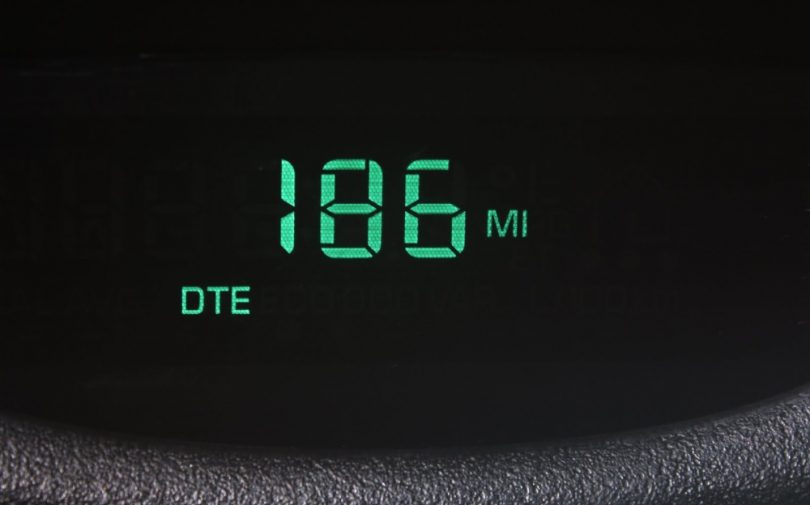There is usually a wide range of indications in your dashboard that informs you about the condition of the car and warns you of any possible dysfunctions within the system. I’m talking about indication systems like the speedometer, fuel gauge, check engine light, and many more.
DTE refers to “Distance To Empty.” This indication system shows you how many miles you can go with your car before the tank runs empty. The indicator is usually displayed as a logo on the LCD, a small icon of a car, just the text, some dots or an arrow, and a fuel pump.
Where Did DTE Come From?

The technological advancement in late ‘70s and early ‘80s brought about sophisticated engine management systems that could accurately measure the fuel used and were able to provide better in-tank measurements of fuel. DTE is the result of that.
Most of the car manufacturers of that time focused on avoiding “running dry” on diesel cars. Not only “running dry” could mean getting your tanks empty in the middle of nowhere, but it also meant harming your engine; maybe beyond repair.
The DTE indicator was invented to combat that problem. It showcases an approximate value of how much you can drive on your remaining fuel so you can be prepared or take your car to the nearest gas station.
This method seemed way better than dealing with a damaged engine or a drained battery. Over time, the DTE indication became more mainstream, and most new cars feature this nowadays.
Is Empty Not Really Empty?
It may seem a little spooky to you, but your car can run a few miles even when the indicator shows your fuel tank empty. This just means that your car manufacturer knows human nature and has allowed a reserve. So empty is not really empty now, or is it?
Most cars will display the empty sign once the tank has less than a gallon of gas left. However, that little trick almost failed as the manufacturer understood how unlikely of us it is to refuel our tanks regularly.
Consequently, we need to be careful about the DTE indication. Many things can affect your fuel economy and mileage. For example, a 30-mile indication can decrease dramatically if your car is stuck in traffic and moving very slowly.
The DTE isn’t an absolute value. It just provides a rough estimation. We need to have either backup fuel ready at all times or refuel the car once we get that chance rather than when you are bound to do so.
How does your car calculate DTE
As I’ve mentioned earlier, the DTE measurement depends on many factors. The things that influence DTE the most are your fuel quality and your driving style. Premium grade fuel will not only increase your DTE and fuel economy but also will keep the engine healthy for longer.
Your driving style is another big influencer on how far you can go with what you have left in your tank. In case you have a lead foot and drive with your foot to the floor, your DTE will drop significantly.
Based on these calculations and the MPG (Miles Per Gallon) rating of your car, you’ll see an approximate indication that will help you to be prepared for anything.
Are DTE counters accurate?
Technically, yes. The DTE counters only give you a rough estimation and don’t consider factors like traffic condition, road elevation, weather, and other external factors that may affect your mileage.
For example, going downhill will increase your DTE counter whereas being stuck in traffic will decrease it. To be safe, don’t take your DTE counters to be exactly accurate. If your counter shows you have 10 miles left, it would be safe to assume you have even less, like 6-7 miles.
We recommend that you treat your DTE counter as a guideline rather than something set in stone. A safer practice would be to keep your tank ¼ part full at all times.
What about electric cars?
Now, you might be wondering about how EVs calculate their DTE, or do they actually have any, right? Well, Most EVs (Electric Vehicles) display remaining mileage as a primary function.
Unlike conventional cars, EVs don’t have any reserve; so once your DTE hits zero, you’re pretty much doomed. Moving an out-of-fuel EV is much harder than moving a gas-powered one.
That’s why most EVs make it painstakingly hard to ignore The DTE indicator. Higher-end EVs (like Tesla) will also notify you when you go out of range of a charging point and give you heads-up before shutting down. Some other EVs enable a special power-saving mode.
One thing is worth mentioning here. Unlike traditional cars, EVS only use the energy they need to move, and sitting in traffic with only basic ventilation doesn’t need much power.
If you have an EV that’s low on power, there is a service station within the range, and you’re sitting in traffic, hang in there even if the journey takes a couple of hours. Reaching from the station will be much faster and more secure than using some shady wall outlet.
How to Reset Distance to Empty
Some cars come with a dedicated button to reset the DTE indicator. You just press the button when you want to reset or switch the button off. For the cars that don’t have a dedicated button or switch, the procedure goes something like this:
- Turn off your car’s engine
- Remove the ignition key
- Wait about two minutes
- Reinsert the ignition key into its position
You’re done! Your DTE indicator has been reset. Even if you don’t have a built-in DTE indicator, you can install one from the aftermarket.
FAQs
1. What number of miles can you drive on purge?
Ans: On average, a modern car can go about 30-50 miles from the moment when the fuel light turns on to emptying the tank completely. The number greatly depends on the fuel quality, your driving style, and the condition of the road.
2. Is it bad to run your car on low fuel?
Ans: Yes. You can run your car on low fuel in emergencies. However, doing so will damage your fuel pump over time. Dirt particles accumulated in the fuel usually settle at the bottom of your tank. When you run low on fuel, you risk damaging your fuel pump with debris.
3. Does every car have a DTE indicator?
Ans: No. Older cars don’t have a DTE indicator. Instead, they featured just a gas gauge. Modern cars sold in the US since 2001, however, need to have a readout of DCOT (Distance To Empty), ETC (Estimated Time to Empty) by the law.
4. Does driving with AC off save gas?
Ans: Technically, yes. However, the amount isn’t enough to really matter that much. You can save a little amount of gas by keeping the AC off, but the changes won’t be noticeable.
5. How much reserve fuel does a car have?
Ans: The amount varies with different brands and models. Some cars can hold about 1 gallon (3.8 liters) of gasoline while other models usually save 10-15% of the total gas volume.










Leave a Comment